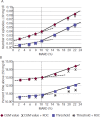The Rationale for Continuous Glucose Monitoring-based Diabetes Treatment Decisions and Non-adjunctive Continuous Glucose Monitoring Use
- PMID: 29632583
- PMCID: PMC5813454
- DOI: 10.17925/EE.2016.12.01.24
The Rationale for Continuous Glucose Monitoring-based Diabetes Treatment Decisions and Non-adjunctive Continuous Glucose Monitoring Use
Abstract
Self-monitoring of blood glucose (SMBG) is now recognised as a core component of diabetes self-management. However, there are many limitations to SMBG use in individuals with diabetes who are treated with intensive insulin regimens. Many individuals do not test at the recommended frequencies. Additionally, because SMBG only provides a blood glucose reading at a single point in time, hypoglycaemia and hyperglycaemia can easily go undetected, limiting the user's ability to take corrective action. Inaccuracies due to user error, environmental factors and weaknesses in SMBG system integrity further limit the utility of SMBG. Real-time continuous glucose monitoring (CGM) displays the current glucose, direction and velocity of glucose change and provides programmable alarms. This trending information and 'around-the-clock' vigilance provides a significant safety advantage relative to SMBG. No published clinical studies have evaluated outcomes when CGM is used as a replacement for SMBG; however, recent in silico studies support this indication. This article reviews the limitations of SMBG and discusses recent evidence that supports CGM-based decisions as an effective approach to managing insulin-treated diabetes.
Keywords: Continuous glucose monitoring (CGM); continuous subcutaneous insulin infusion (CSII); glucose monitoring; glucose trend; multiple-dose insulin (MDI); rate of change; self-monitoring of blood glucose (SMBG).
Conflict of interest statement
Disclosure: David Price and Tomas Walker are employees of Dexcom, Inc.
Figures



References
-
- Diabetes Control and Complications Trial Study Group, The effect of intensive treatment of diabetes on the development and progression of long-term complications in insulin-dependent diabetes mellitus. N Engl J Med. 1993;329:977–86. - PubMed
-
- Cryer PE. Hypoglycemia: still the limiting factor in the glycemic management of diabetes. Endocr Pract. 2008;14:750–6. - PubMed
-
- Miller KM, Foster NC, Beck RW. Network TDEC: Current state of type 1 diabetes treatment in the U.S.: updated data from the T1D Exchange clinic registry. Diabetes Care. 2015;38:971–8. - PubMed
-
- Giorda CB, Ozzello A, Gentile S. Incidence and risk factors for severe and symptomatic hypoglycemia in type 1 diabetes. Results of the HYPOS-1 study. Acta Diabetol. 2015;52:845–53. - PubMed
-
- Cariou B, Fontaine P, Eschwege E. Frequency and predictors of confirmed hypoglycaemia in type 1 and insulin-treated type 2 diabetes mellitus patients in a real-life setting: results from the DIALOG study. Diabetes Metab. 2015;41:116–25. - PubMed
Publication types
LinkOut - more resources
Full Text Sources
Other Literature Sources
Molecular Biology Databases
